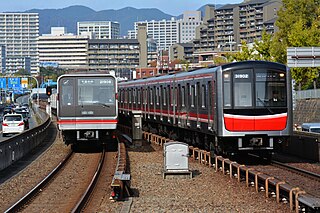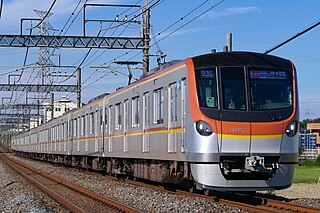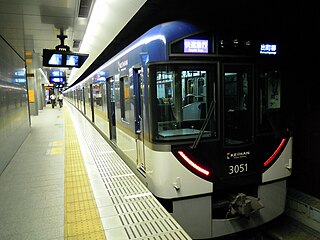This article needs to be updated.(March 2011) |
| Years in rail transport |
|---|
| Timeline of railway history |
This article lists events related to rail transport that occurred in 2008.
This article needs to be updated.(March 2011) |
| Years in rail transport |
|---|
| Timeline of railway history |
This article lists events related to rail transport that occurred in 2008.


This section has multiple issues. Please help improve it or discuss these issues on the talk page . (Learn how and when to remove these messages)
|

The Osaka Metro is a major rapid transit system in the Osaka Metropolitan Area of Japan, operated by the Osaka Metro Company, Ltd. It serves the city of Osaka and the adjacent municipalities of Higashiosaka, Kadoma, Moriguchi, Sakai, Suita, and Yao. Osaka Metro forms an integral part of the extensive mass transit system of Greater Osaka, having 123 out of the 1,108 rail stations (2007) in the Osaka-Kobe-Kyoto region. In 2010, the greater Osaka region had 13 million rail passengers daily of which the Osaka Municipal Subway accounted for 2.29 million.

Kita-Osaka Kyuko Railway is a railway operator in Osaka Prefecture, Japan. Its sole line, officially named the Namboku Line, operates as a through-service extension of the Midōsuji Line of the Osaka Metro.

Hakata Station is a major railway station in Hakata-ku, Fukuoka, Japan. It is the largest and busiest railway terminal in Kyushu, and is a gateway to other cities in Kyushu for travelers coming from Honshu by rail travel. The San'yō Shinkansen from Osaka ends at this station.

The Minatomirai 21 Line, commonly known as the Minatomirai Line, is a subway line in Yokohama, Japan that runs from Yokohama Station to Motomachi-Chūkagai Station through the Minatomirai 21 business district. The line opened in 2004 and is operated by the Yokohama Minatomirai Railway Company.

The Tokyo Metro Hibiya Line is a subway line in Tokyo, Japan, owned and operated by Tokyo Metro. The line was named after the Hibiya area in Chiyoda's Yurakucho district, under which it passes. On maps, diagrams and signboards, the line is shown using the color silver, and its stations are given numbers using the letter "H".

The Osaka Higashi Line is a railway line in Osaka, Japan, operated by the West Japan Railway Company (JR-West). The line connects Ōsaka Station in northern Osaka with Kyūhōji Station in Yao, forming an arc around the northern and eastern suburbs of the city. Before being named on August 23, 2007, the line was constructed with the tentative name "Osaka Outer Loop Line".

The Tokyo Metro Yurakucho Line is a subway line in Japan owned and operated by Tokyo Metro. The line connects Wakōshi Station in Wakō, Saitama and Shin-Kiba Station in Kōtō, Tokyo. On maps, diagrams and signboards, the line is shown using the color "gold", and its stations are given numbers using the letter "Y".

The Osaka Metro Chūō Line is a rapid transit system in Osaka, Japan, operated by Osaka Metro. The line runs east-westerly under Chūō Avenue. Its official name is Rapid Electric Tramway Line No. 4 (高速電気軌道第4号線), and in MLIT publications, it is written as Line No. 4 . Station numbers are indicated by the letter C.

The Tokyo Metro Fukutoshin Line, formally the No. 13 Fukutoshin Line, is a 20.2-kilometer (12.6 mi) subway line operated by Tokyo Metro in west-central Tokyo and Wako, Saitama, Japan. The newest line in the Tokyo subway network, it opened in stages between 1994 and 2008. On average, the Fukutoshin Line carried 362,654 passengers daily in 2017, the lowest of all Tokyo Metro lines and roughly one third of its sister Tokyo Metro Yūrakuchō Line (1,124,478).

The Osaka Metro Midōsuji Line is a rapid transit line in Osaka, Japan, operated by Osaka Metro. Constructed under Midōsuji, a major north-south street, it is the oldest line in the Osaka subway system and the second oldest in Japan, following the Tokyo Metro Ginza Line. Its official name is Rapid Electric Tramway Line No. 1 (高速電気軌道第1号線), while the Osaka Municipal Transportation Bureau refers to it as Osaka City Rapid Railway Line No. 1 (大阪市高速鉄道第1号線), and in MLIT publications it is referred to as Line No. 1 . On line maps, stations on the Midōsuji Line are indicated with the letter "M".

The Keihanna Line is a railway line operated by Kintetsu Railway. There are through trains to the Chūō Line of Osaka Municipal Subway. The line name derives from a kanji acronym formed from Kyoto (京都), Osaka (大阪), and Nara (奈良), but the name is written in hiragana.

The Nanakuma Line (七隈線, Nanakuma-sen) is a subway line, part of the Fukuoka City Subway system in Fukuoka, Japan. It runs from Hashimoto Station in Nishi Ward to Hakata Station in Hakata Ward, all within Fukuoka. The line's color on maps is green. Officially, the line is called Line 3 (Nanakuma Line) (3号線(七隈線), San-gō-sen (Nanakuma-sen)). Like other Fukuoka City Subway lines, stations are equipped with automatic platform gates, and trains are automatically operated by ATO system.

The Tokyo Metro 01 series was an electric multiple unit (EMU) train type operated by the Tokyo subway operator Tokyo Metro on the Tokyo Metro Ginza Line subway in Tokyo, Japan, from 1983 until March 2017. A total of 38 six-car trainsets were built between 1983 and 1997 in five batches, and the design received the 25th Laurel Prize of the Japan Railfan Club in 1985.

The Yokohama Municipal Subway Green Line is a rapid transit line serving Yokohama in Kanagawa Prefecture, Japan. It is the shorter of the two lines in the Yokohama Municipal Subway system operated by Yokohama City Transportation Bureau. Its formal designation is Line 4, and it is the first section to be opened of a proposed Yokohama Circular Railway.

The Keihan Nakanoshima Line is a railway line operated by the Keihan Electric Railway in Osaka, Japan. It opened on October 19, 2008, and has a ruling grade of 1 in 25 (4%).

The Osaka Municipal Subway/Osaka Metro 30000 series (大阪市交通局・大阪メトロ30000系) is a rapid transit electric multiple unit (EMU) train type operated by Osaka Municipal Subway in Japan since 2009.

The Osaka Metro Sakaisuji Line is an underground rapid transit line in Osaka, Japan, operated by Osaka Metro. Its official name is Rapid Electric Tramway Line No. 6 (高速電気軌道第6号線), and in MLIT publications, it is written as Line No. 6 .

The Tōkyū Shin-Yokohama Line (東急新横浜線) is a commuter line operated by Tokyu Corporation connecting Hiyoshi Station on the Tōkyū Tōyoko and Meguro lines to Shin-Yokohama Station on the Sōtetsu Shin-Yokohama Line. Tōkyū has put its company name as a formal part of the line name, which is a second for Tōkyū, following the Tōkyū Tamagawa Line.

The Osaka Municipal Subway/Osaka Metro 10 series (大阪市交通局・大阪メトロ10系) was a rapid transit electric multiple unit (EMU) train type operated by Osaka Municipal Subway in Japan between 1976 and 2022.